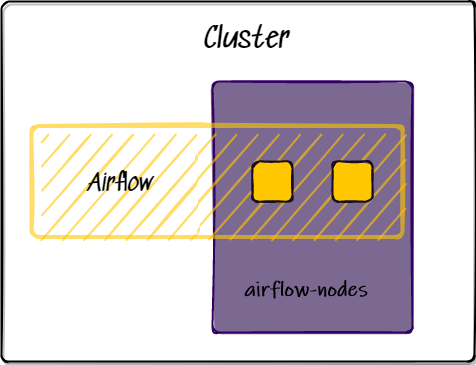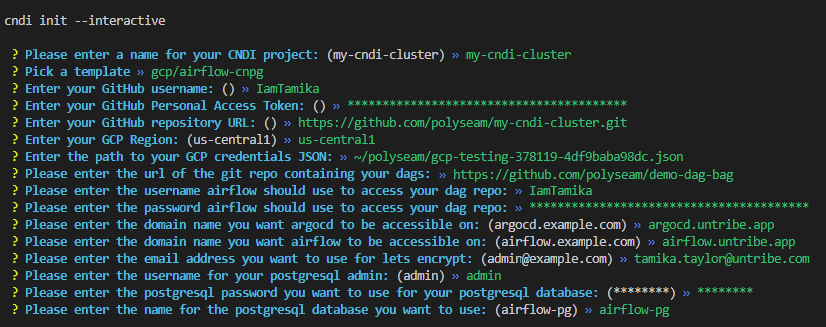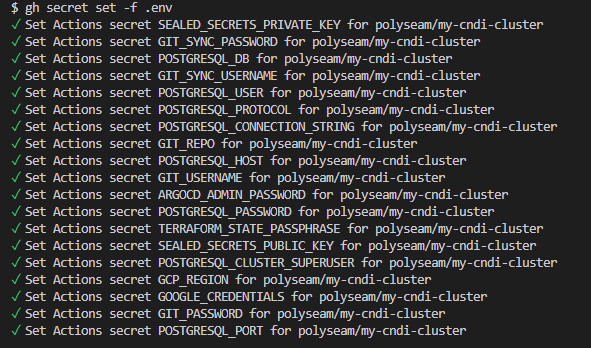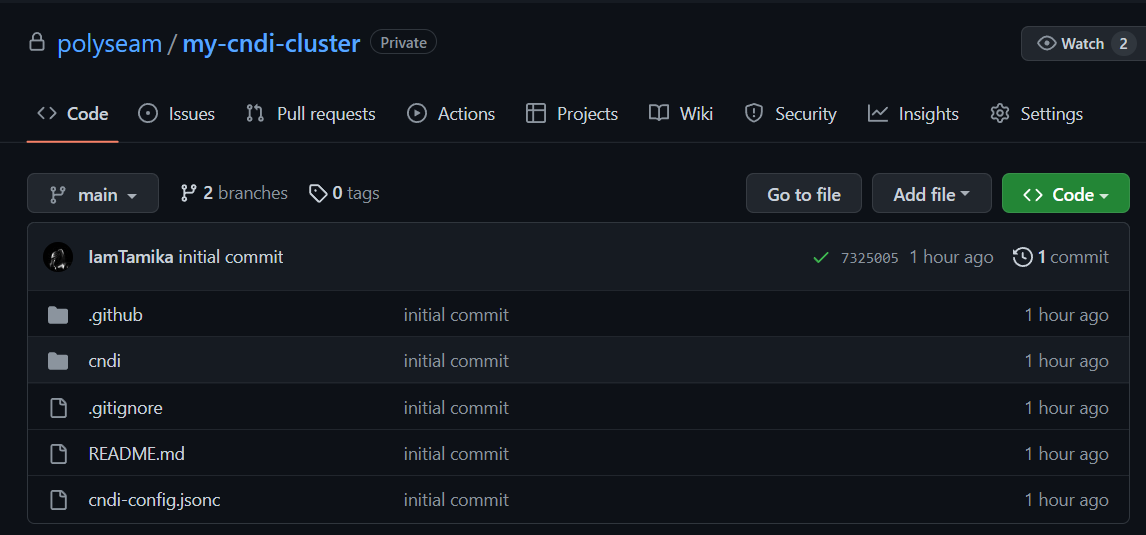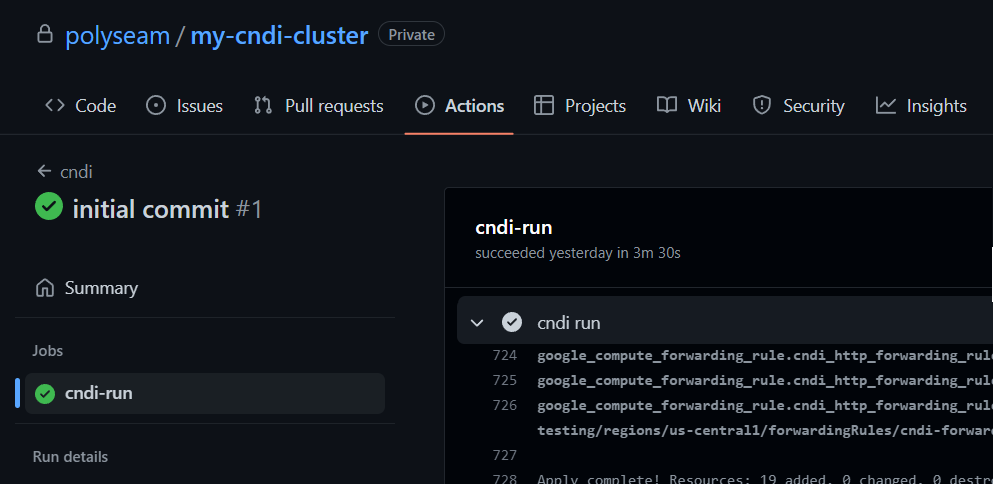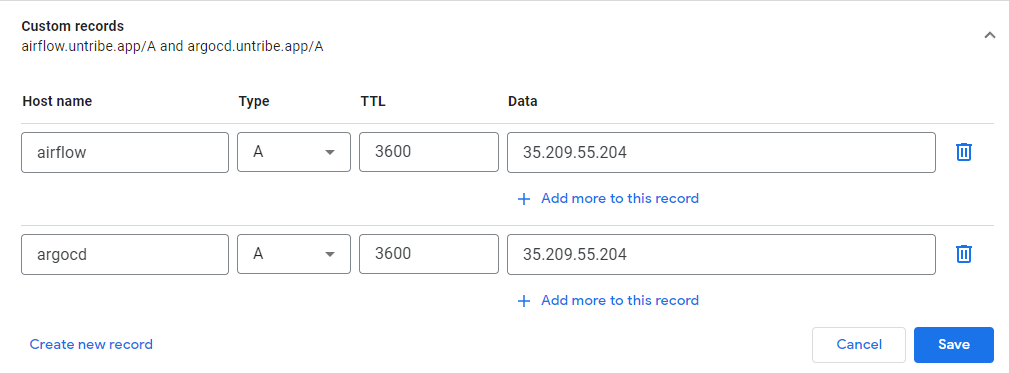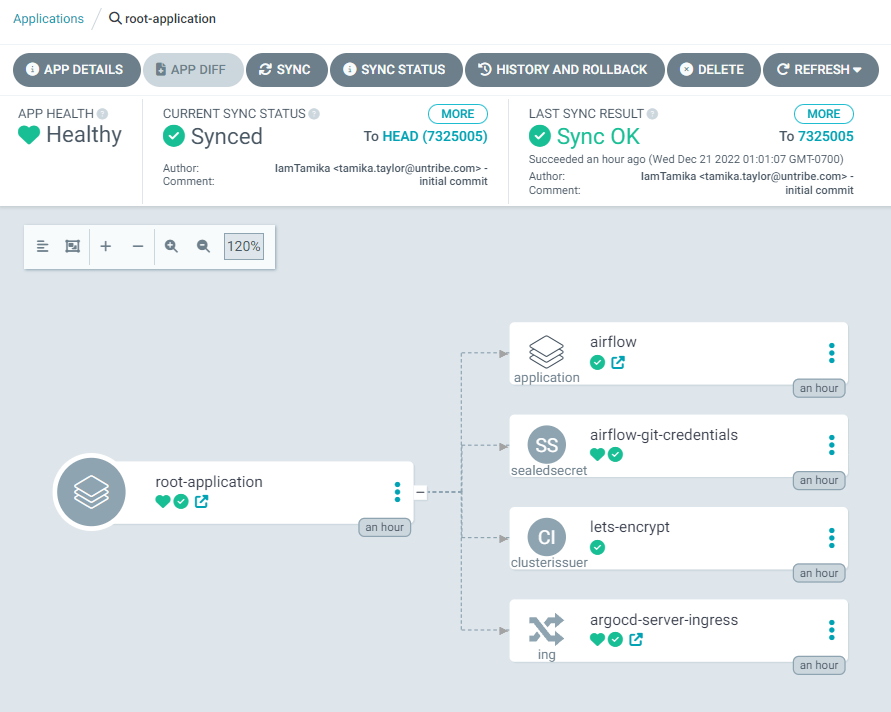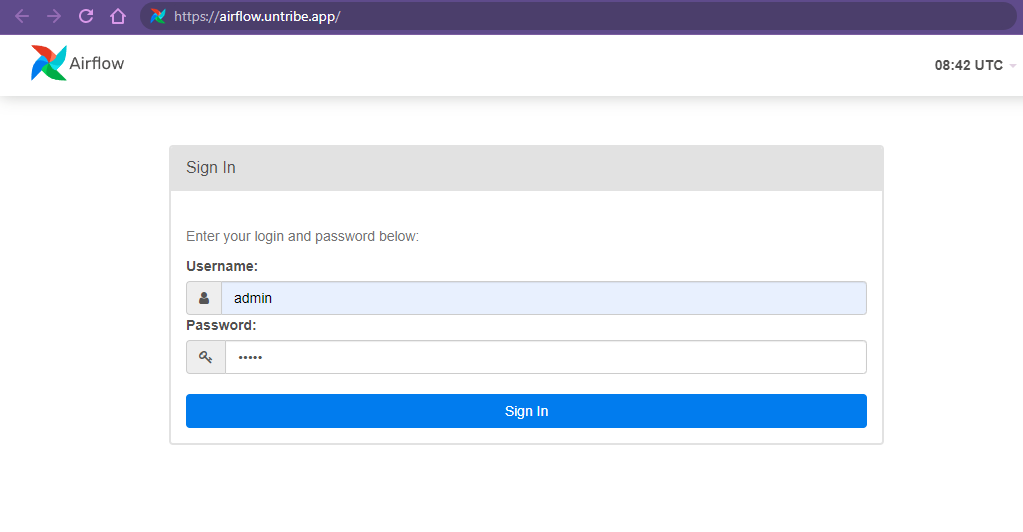A guide for using CNDI to deploy a GitOps enabled Airflow cluster on Kubernetes in Google Cloud Platform
This walkthough uses cndi to customize and deploy our gke/airflow Template.
In just a few minutes we will be able to deploy a new Kubernetes cluster to GKE
that has been optimally configured for Airflow, including GitOps with Secrets
management, TLS and High Availibility right out-of-the-box. This framework will
enable quick iteration of infrastructure, applications and manifests in a GitHub
workflow you are already comfortable with.
You will need the following things to get up and running with cndi successfully:
-
A GCP account and a GCP project: cndi will deploy infrastructure into a Google Cloud Project connected to a valid billing account.
-
Your GCP service account credentials: cndi will leverage a Google Cloud Service Account using a service-account-key.json credentials file to deploy resources.
-
A Domain Name: Because the
gke/airflowtemplate sets up TLS certificates, we need to have a domain on which to apply them. We also need access to the domain registrar so we can add a coupleArecords there for our cluster Ingresses. -
(Optional if you dont have an domain name) Here's a guide of how to connect to your Google Kubernetes Cluster once its deployed and Port Forward Argocd and the Airflow Web Server
-
A GitHub account: cndi helps you manage the state of your infrastructure using a GitOps workflow, so you'll need a GitHub account with a valid GitHub Personal Access Token.
-
Here's a guide of how to set up your Google Cloud account including roles and permissions
Run the following command within your terminal to download and install cndi:
# this will download the correct binary for your OS
curl -fsSL https://raw.githubusercontent.com/polyseam/cndi/main/install.sh | shCNDI is designed around a GitOps workflow, so all of your cluster configuration and infrastructure will be stored as code within a git repo, let's create that now!
gh repo create my-cndi-cluster --private --clone && cd my-cndi-clusterNow that we have a repo, let's use cndi to generate all of our Infrastructure
as Code and Cluster Configuration:
cndi init --interactiveYou will get an interactive prompt where you'll name your project, then one to specify the CNDI template you want.
For this project select the gke/airflow Template.
? Pick a template
ec2/basic
gke/basic
avm/basic
ec2/airflow
avm/airflow
❯ gke/airflowBelow is the list of all of the interactive prompt values that should be supplied for this project:
- Cndi Project Name: name of project
- Template: list of templates to choose from
- GitHub Username: a user's handle on GitHub.
- GitHub Repository URL: the url for the GitHub repository that will hold all cluster configuration
- GitHub Personal Access Token: the access token CNDI will use to access your repo for cluster creation and synchronization
- GCP Region: region where the infastructure is being created
- Path to GCP service account key json: path to JSON credentials file for GCP Service Account
- Git Username for Airflow DAG Storage: a user's handle on GitHub used to synchronize Airflow DAGs
- Git Password for Airflow DAG Storage: a personal access token used to synchronize Airflow DAGs
- Git Repo for Airflow DAG Storage: url for repo where your Airflow DAGs will be stored
- Domain name you want ArgoCD to be accessible on: domain where ArgoCD will be hosted
- Domain name you want Airflow to be accessible on: domain where Airflow will be hosted
- Email address you want to use for lets encrypt: an email for lets encrypt to use when generating certificates
- Username you want to use for airflow cnpg database: username you want to use for airflow database
- Password you want to use for airflow cnpg database: password you want to use for airflow database
- Name of the postgresql database you want to use for airflow cnpg database: name of the postgresql database you want to use for airflow cnpg database
This process will generate a cndi_config.yaml file, and cndi directory at
the root of your repository containing all the necessary cluster and
infrastructure resources. It will also generate a .env file that will be used
to store sensitive information that we don't want to commit to our repository as
source code.
The structure of the generated CNDI project will be as follows:
├── 📁 cndi
│ ├── 📁 cluster_manifests
│ │ ├── 📁 applications
│ │ │ └── airflow.application.yaml
│ │ ├── argo-ingress.yaml
│ │ ├── cert-manager-cluster-issuer.yaml
│ │ └── git-credentials-secret.yaml
│ └── 📁 terraform
│ ├── aks_cluster_airflow_nodes.tf.json
│ └── etc
├── cndi_config.yaml
├── .env
├── .gitignore
├── .github
└── README.mdFor a breakdown of all of these files, checkout the outputs section of the repo's main README.
GitHub Actions is responsible for calling the cndi run command to deploy our
cluster, so it is important that our secrets are available in the actions
runtime. However we don't want these to be visible in our source code, so we
will use GitHub Actions Secrets to store them. The
gh CLI makes this very easy.
gh secret set -f .env
# if this does not complete the first time, try running it again!Once all the config is created and environment variables are uploaded to GitHub, add, commit and push the config to your GitHub repository:
git add .
git status # take a quick look and make sure these are all files you want to push
git commit -m "initial commit"
git push --set-upstream origin mainYou should now see the cluster configuration has been uploaded to GitHub:
Now, open your web browser and navigate to your project on GitHub. Click on the Actions tab, then click on the job that was triggered from your latest commit.
You will see something like the image below, which shows that GitHub has successfully run the workflow.
It is common for cndi run to take a fair amount of time, as is the case with
most Terraform and cloud infrastructure deployments.
Once cndi run has been completed, at the end of the run will be a link to
resource group, where you can view resources deployed by CNDI for this
project. 
At the end of the cndi run there is also an output called public host, which
is the IP address (A record) of the load Balancer thats attached to your GKE
instances.
- Copy
public host - Go to your custom domain,
- Create an A record to route traffic to the load balancer IP address
public hostfor Airflow and Argocd at the domain you provided.
- (Optional if you dont have an domain name) Here's a guide of how to connect to your Google Kubernetes Cluster once its deployed and Port Forward Argocd and the Airflow Web Server
Wait 2 to 5 mins to open the domain name you've assigned for ArgoCD in your browser in order to see the Argocd UI Login page.
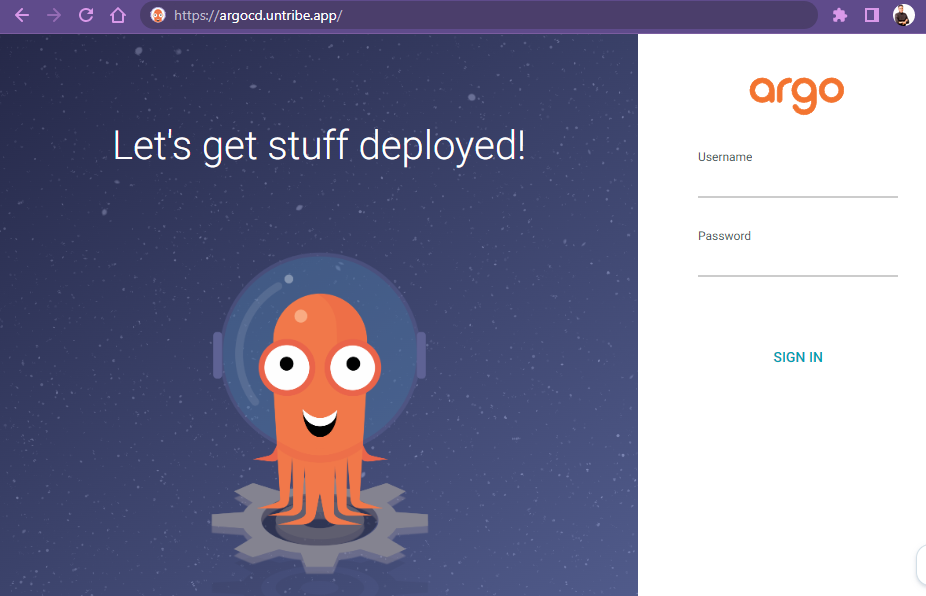
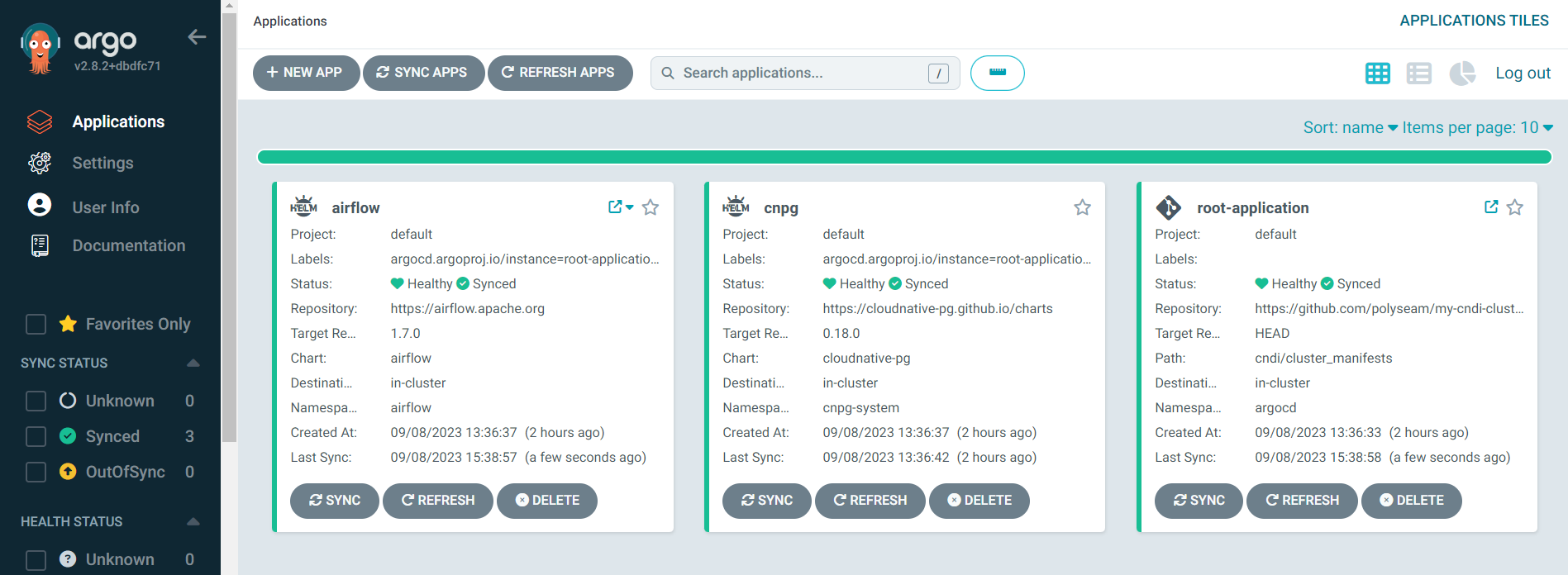 To log in, use the
username
To log in, use the
username admin and the password which is the value of the
ARGOCD_ADMIN_PASSWORD in the .env located in your CNDI project folder
Notice that the cluster_manifests in the GitHub repository matches config in
the ArgoCD UI
└── 📁 cndi
└── 📁 cluster_manifests
├── 📁 applications
| ├── cnpg.application.yaml
| └── airflow.application.yaml
├────── git-credentials-secret.yaml
├────── cert-manager-cluster-issuer.yaml
└────── argo-ingress.yamlVerify all applications and manifests in the GitHub repository are present and their status is healthy in the ArgoCD UI
After setting up your Airflow application on the chosen domain, it is necessary
to verify that Airflow is accessible. To do this, the user can simply go to the
chosen domain and see if they can see Airflow's login page. The default username
is admin and the password is admin. If the page is accessible, then the user
can log in and begin using Airflow. If not, the user should go back and make
sure the previous steps were done correctly.
Verify that Airflow is connected to the private DAG repository. If correct, the private DAGs should be visible on the Airflow UI. If not,you should go back and make sure that the private DAG repository is properly connected to Airflow with the correct credentials:
You now have a fully-configured 3-node Kubernetes cluster with TLS-enabled Airflow and ArgoCD.
To add another a node to the cluster:
- Go to the
cndi_config.yaml - In the
infrastructure.cndi.nodessection, add a new airflow node and save the file - Run
cndi ow - Commit changes
- Push your code changes to the repository
If you just want to take down any of your individual applications:
- Delete that application or manifest from your
cndi_config.yaml - Run cndi ow
- Commit changes
- Push your code changes to the repository
If you want to take down the entire cluster run:
cndi destroy